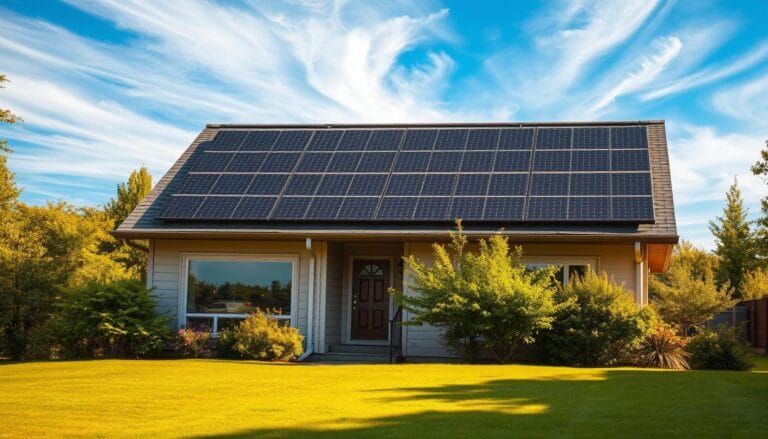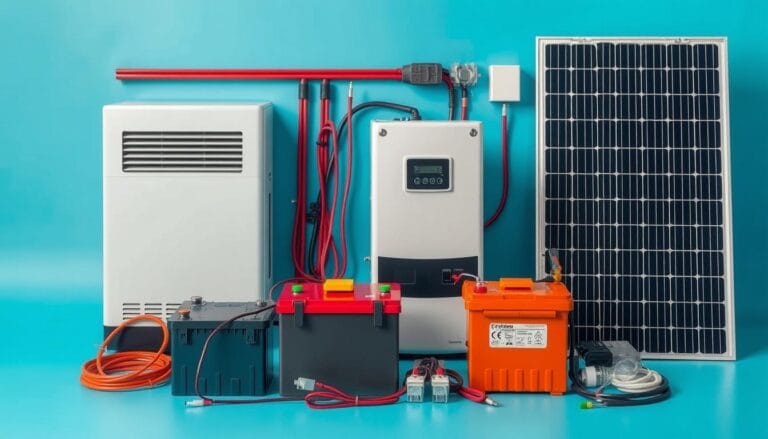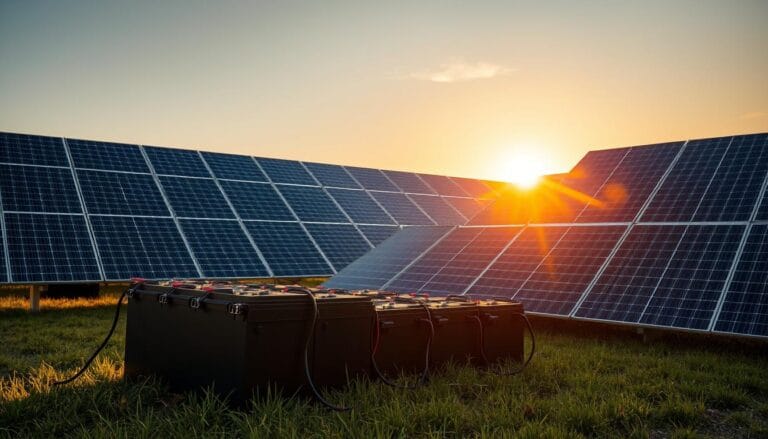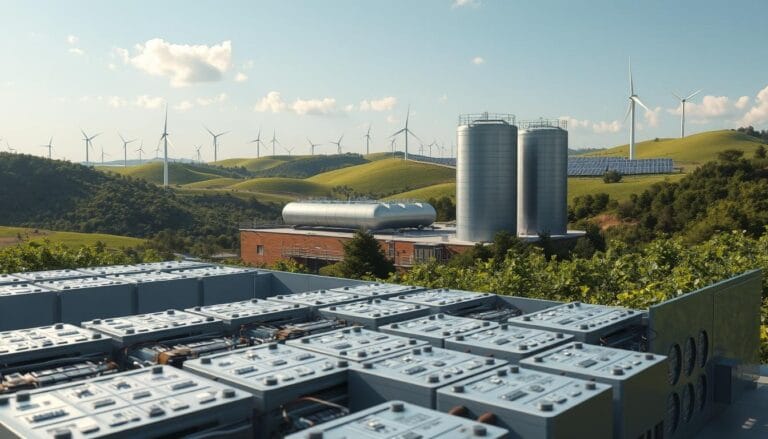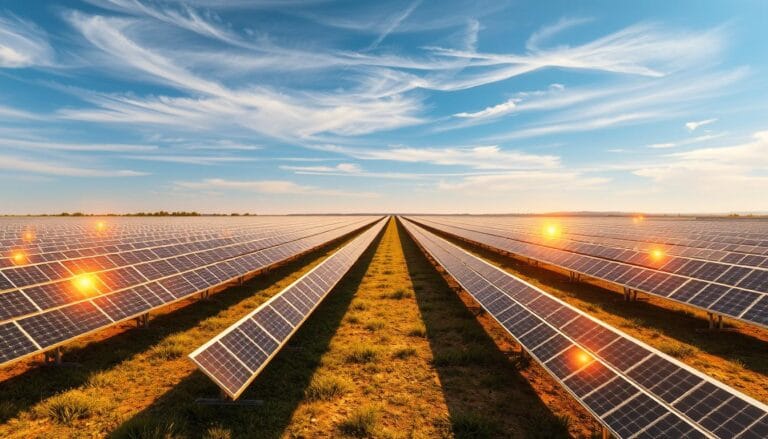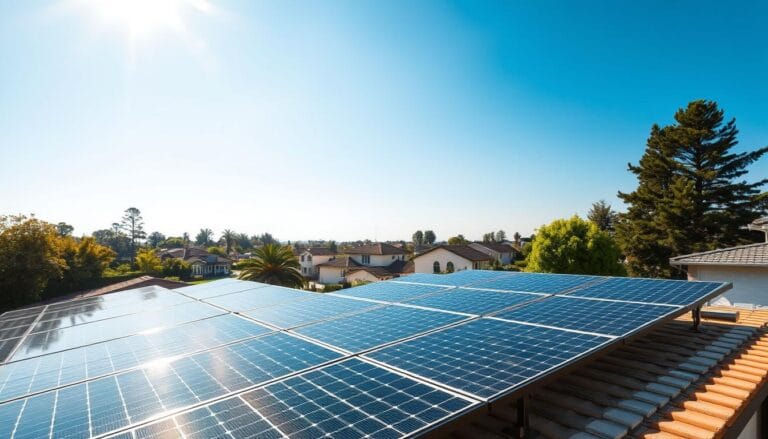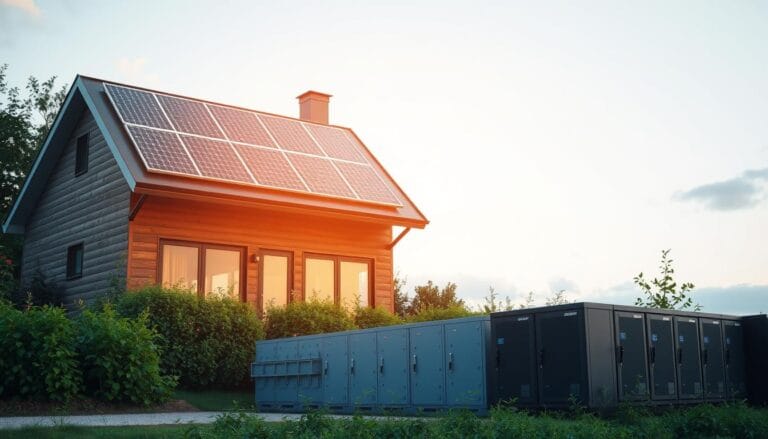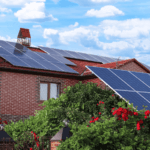Solar energy is both abundant and endless, making it a top choice for renewable energy. The sun will shine for billions of years, making solar power a key part of sustainable energy solutions. Did you know the Earth gets more solar energy in one hour than we use in a year? This shows how much potential solar has.
Solar energy facts show it’s good for the planet. Solar panels last 20 to 30 years and can even be recycled. They’re quiet, have no moving parts, and don’t pollute, fitting perfectly with green energy technology. Using solar energy helps the environment and fights the use of limited fossil fuels.
Key Takeaways
- Renewable and infinite, solar energy’s availability extends as long as the sun shines.
- Substantial energy yield: One hour of sunlight can theoretically meet annual global energy demand.
- The lifecycle of solar panels supports the broader sustainability narrative due to its durability and recyclability.
- Adopting solar requires a fraction of Earth’s total land area to supplant current electricity needs.
- Solar’s return on energy investment is rapid and concludes within a mere 1-2 years of operation.
- Sustainable practices are bolstered by solar energy’s almost negligible environmental impact.
- Long-term economic benefits of solar energy are reflected in its minimal maintenance costs and governmental incentives.
The Essence of Solar Power as a Clean Energy Source
Solar power is a big step towards eco-friendly energy. It’s a key player in clean energy options. By looking into solar energy, we see it’s sustainable and crucial for a healthier planet.
Lasting Impact and Diminishing Carbon Footprints
Solar technology has greatly reduced the carbon footprints from energy production. Studies show solar power doesn’t emit carbon, changing how industries affect global emissions. For example, solar power’s rise has led to a drop in CO2 emissions from the power sector.
This shows solar energy’s role in creating a sustainable future.
The Growth of Solar Panel Recycling Methods
The solar industry is getting better with recycling old panels. This makes new panels and cuts down on waste and resource use. Companies like SunPower and Maxeon are leading the way in making solar panels sustainable.
This effort boosts solar power’s benefits and makes it a key clean energy choice. Solar power is a zero-emission source, changing energy systems worldwide. It’s setting the stage for a future focused on renewable energy.
The use of solar power has grown a lot from 2010 to 2020. This shows a global move towards sustainable energy. These numbers show a big win for technology and a growing trust in solar power as a clean energy source.
Understanding solar energy and its potential is key for those wanting clean, sustainable practices. Solar energy cuts down on fossil fuel use and helps reduce energy conflicts. As we use more solar power, its importance as an eco-friendly source grows.
Using the sun’s power can greatly help fight global warming and support green jobs and tech. The future looks bright with solar power leading the fight against climate change.
Understanding the Historical Emergence of Solar Energy
The story of solar energy history is fascinating. It shows how ancient people used the sun for basic needs and how we now have advanced technology. A key event was when Alexandre Edmond Becquerel found the photovoltaic effect in 1839. This discovery changed solar power technology a lot.
From Ancient Sun-Focused Techniques to Photovoltaic Discoveries
Long ago, people used sunlight to make fire or design buildings that caught the sun’s rays. The 19th century was a big change with Becquerel’s discovery. He found that some materials make electric current when hit by light. This is now called the photovoltaic effect.
The Invention of Practical Solar Cells and Its Significance
Years went by before we saw practical uses of Becquerel’s discovery. In 1954, Bell Labs made the first silicon photovoltaic cell. This cell turned sunlight into electricity at four percent efficiency. This was a big step forward.
It led to the first satellite powered by solar panels in 1958. This marked the start of modern solar technology.
A table shows key events in solar panel history. It shows how solar technology got better and costs went down:
| Year | Development | Efficiency/Cost |
|---|---|---|
| 1954 | First silicon solar cell by Bell Labs | 4% efficiency |
| 1985 | University of New South Wales’ 20% efficiency milestone | 20% efficiency |
| 2016 | Record-high 34.5% efficiency at UNSW | 34.5% efficiency |
| 1956 | Cost of solar cells high at $300/watt | $300 per watt |
| Today | Massive reduction in solar panel prices | Approx. $0.50 per watt |
This timeline shows how solar technology has grown. It’s gone from small uses to big solar farms and even space exploration. The story of solar energy and the photovoltaic effect sets the stage for future green energy breakthroughs.
How Solar Energy is Harvested and Converted into Electricity
The way solar energy turns into electricity is a marvel of modern engineering. At the heart of this is photovoltaic technology. It captures photons and changes them into electrical power.
The Transformation from Photons to Electric Current Explained
Solar panels, made of silicon, are key to this process. They soak up sunlight, causing atoms to release electrons. This creates an electric current, or DC.
How solar energy is produced relies on turning light into electric power. This shows how photovoltaic cells change sunlight into usable energy.
Inverters: The Bridge Between Solar Panels and Appliance Usage
To use the electricity in homes and businesses, it must change from DC to alternating current (AC). An inverter does this. It’s vital because most places use AC power, not DC.
This conversion lets solar power fit into our current energy systems. It makes solar energy a clean, reliable source. This helps us use less carbon, which is good for the planet and our future.
PV Panels vs. Solar Thermal Panels: What’s the Difference?
It’s important to know the difference between PV panels and solar thermal panels if you’re looking into solar options. PV panels and solar thermal panels use the sun’s energy in different ways. Each has its own benefits.
Electricity Generation Compared to Heat Production
Solar PV panels turn sunlight into electricity using the photovoltaic effect. They have cells that make electricity when hit by light. This power is great for homes or businesses.
Solar thermal technology, on the other hand, makes heat, not electricity. It uses panels or mirrors to catch sunlight and heat a fluid. This fluid then heats water or provides heating, showing the advantages of solar energy in heating.
Utilization Variations in Residential and Industrial Applications
Solar PV systems work well in both homes and businesses. They power everything from small devices to big commercial setups. A home setup might include panels, an inverter, and batteries. This setup cuts down on grid use and lowers energy bills.
For heating water at home, solar thermal panels are often used. They’re efficient and take up less space. They’re a good choice for heating but not for making a lot of electricity.
Choosing between solar PV and solar thermal panels depends on your needs and what you want from solar energy. PV is good for making electricity to save on bills. Solar thermal is better for heating. For more info on solar tech, check out Solar Power’s World.
Both solar PV and thermal have big environmental benefits and save money over time. When planning to go solar, talking to a pro for advice is smart. This way, you can make the most of advantages of solar energy.
Deploying Solar Energy at Scale: An Introduction to Solar Farms
Solar farms are key in the push for sustainability. They are big installations that make a lot of solar electricity. This electricity goes into the power grid, making a big difference in how it works.
Learning how solar farms work with the energy grid shows their complexity. They are built to be strong, efficient, and can power large areas. This helps in making the electricity sector cleaner.
How Solar Farms Interface with the Energy Grid
Solar farms are carefully made to produce a lot of energy and fit well with the power grid. They use special systems and tech to turn sunlight into steady electricity.
By 2035, we’ll need more solar farms to make the electricity sector carbon-free. This goal is supported by big investments and policies to grow large-scale solar energy generation.
| Statistic | Details |
|---|---|
| Total U.S. Solar Energy Capacity Potential from Agricultural Land | 115 Terawatts |
| Expected Solar Farm Land Use by 2035 | 0.3% of Farmland |
| Solar Lease Payment Variability Factors | Size, Location, Negotiation Terms |
| Percentage of New U.S. Solar Projects on Agricultural Lands | 83% |
| Projected Solar Deployment on Agricultural Lands by 2040 | Over 7 million acres |
Expanding solar farms means more than just adding panels. It’s about placing them in the best spots for land use and energy production. This move helps us move towards a cleaner energy future. Large-scale solar energy generation is becoming key in the renewable energy world. It’s changing how we think about energy globally.
Can Solar Panels Operate Under Overcast Skies?
Many think solar panels need bright, sunny days to work well. But, solar panel performance under cloudy skies is actually quite strong. Even on rainy days, solar panels keep making energy, just not as much.
It’s key to know how light levels affect solar energy production. Solar tech has gotten better at using light that goes through clouds and fog. This proves solar panels work well even when it’s cloudy.
The Impact of Light Levels on Solar Energy Production
Solar panels keep working even when clouds block the sun. Sometimes, clouds can actually make cloudy weather solar generation better. For example, light bouncing off clouds can increase energy production, especially when the sun peeks through.
Some clouds can even make solar panels work better. Certain clouds act like a magnifying glass, focusing light and boosting energy output. This shows how solar tech can handle different weather.
Today’s solar panels can keep up to 80% of their top performance on cloudy days. This is great for places that often have the weather. It means solar energy is a steady power source all year.
To get the most out of solar panel performance in any weather, using solar batteries is smart. These batteries save extra power from sunny days. Then, they provide energy during cloudy times or at night, keeping the power steady.
Global Leaders in Solar Energy Production
Many countries are now focusing on sustainable energy solutions. They aim to be the biggest producers of solar power. This shift to renewable sources is crucial for a sustainable future.
Examining the Output of Top Solar-Powered Nations
Leading countries are investing heavily in solar power. China stands out, leading in capacity and technology. It’s a world leader in solar energy.
| Country | Significant Achievements in Solar Power (2023) | Future Targets |
|---|---|---|
| China | Installed capacity far exceeds other nations, significant reduction in fossil fuel dependency, largest share in global solar manufacturing. | Aim for 3.9 terawatts of renewables by 2030. |
| United States | Diversify energy portfolio, increase in residential and commercial solar installations. | Double renewable generation by 2030. |
| Germany | Nearly half of the national power consumption through renewables, pioneering technology in solar panel efficiency. | 80% renewable power by 2030, aiming for nearly 100% by 2035. |
| India | Significant growth in solar farms and solar parks, leading in the adoption of solar in rural and urban landscapes. | 450 GW of renewable energy capacity by 2030, major focus on solar. |
| Japan | Advanced technology in photovoltaic cells, substantial investment in solar-related research. | Renewables to account for 22-24% of power generation by 2030. |
This table shows the big achievements in solar energy from top countries. They’re not just growing their solar power. They’re also setting big goals for the future to make our planet greener.
Is Solar Energy a Renewable Resource?
Is solar energy a renewable resource? The answer is a clear yes. It comes from the sun’s natural nuclear fusion. This process keeps giving us energy, making solar energy sustainable.
The Role of Nuclear Fusion in Sustaining Solar Energy
Nuclear fusion in the sun is key to solar energy being renewable. It happens when hydrogen atoms combine, creating helium and lots of energy. This energy supports life on Earth and is available for us to use.
Solar energy is a renewable source because it comes from the sun’s constant energy release. Unlike fossil fuels, it won’t run out. Let’s look at some facts to see how solar energy makes a difference:
| Solar Energy Characteristic | Statistic | Comparison/Impact |
|---|---|---|
| Carbon footprint per kWh | 50 grams CO2 | 20x less than coal |
| Lifespan of Panels | 25-30 years | Can extend beyond 30 years for high-quality panels |
| Carbon offsetting post-installation | Few months | Quickly compensates for production emissions |
| Environmental impact during use | None | No contamination of water, soil, or air |
| Energy independence capability | Off-grid potential | Reduces reliance on conventional electric grids |
This information highlights solar energy’s strength as a renewable source. It also shows its big role in reducing our use of non-renewable energy. Switching to solar helps protect the environment and supports a sustainable energy future.
Solar Energy’s Multifaceted Contributions to Earth’s Climate
Solar energy does more than just give us a clean power source. It deeply affects Earth’s climate systems. It plays a big role in important environmental processes like the greenhouse effect and photosynthesis. It also helps make fossil fuels. Understanding how solar energy works with our planet is key to making sustainable energy policies.
Fueling the Greenhouse Effect and Photosynthesis
Solar energy is key to photosynthesis, turning light into energy for plants. This supports life on Earth and helps control the impact on climate by managing carbon levels. It also warms the Earth, which is good for the greenhouse effect. This effect keeps temperatures right for life and ecosystems.
The Origin Story of Fossil Fuels from Ancient Solar Energy
The link between fossil fuels and solar energy goes way back. Old organic stuff, once getting sunlight through photosynthesis, turned into coal, oil, and gas over millions of years. This old solar energy, stored by ancient plants and tiny life forms, is what we use today. Knowing this helps us see why solar energy is better than fossil fuels and why we should move to renewable sources.
In short, solar energy helps with photosynthesis and affects the climate. It even helps make fossil fuels. By using photosynthesis and solar energy, we can lessen our need for fossil fuels. This leads to a sustainable and strong energy future.
Architectural Integration and Adoption of Solar Technologies
The growth of solar architecture is closely linked with active and passive solar energy in building design. As we move towards sustainability, combining architecture with solar tech is key. This blend meets environmental rules and sets new standards in design and use.
Active solar energy systems like photovoltaic panels turn sunlight into electricity or heat. This boosts building energy efficiency and cuts down on fossil fuel use. Passive solar energy uses building design to make the most of sunlight. It helps with heating and cooling without using much energy.
The Rise of Active and Passive Solar Energy Utilization
Using both active and passive solar tech is becoming more popular. It lowers costs and makes buildings less dependent on non-renewable energy. Buildings with active solar tech, like Building Integrated Photovoltaics (BIPV), make power and add to the building’s look and function. Passive designs use smart materials and windows to cut down on cooling and heating needs.
Photovoltaics: Powering Devices Large and Small
Photovoltaic tech works in big buildings and small homes, powering many devices. It’s getting more popular in sunny places like Australia, thanks to government support and the need to fight climate change. New tech like transparent solar panels could make every building surface a solar energy source.
| Integration Feature | Benefits | Example Applications |
|---|---|---|
| Building Integrated Photovoltaics (BIPV) | Energy production, aesthetic enhancement, cost savings | Facade cladding, roofing materials |
| Passive Solar Design | Reduces HVAC costs, maximizes natural lighting | Strategic window placement, thermal mass usage |
| Active Solar Technologies | Direct electricity and heat generation | Solar panels, solar thermal systems |
As solar architecture grows, the mix of active and passive solar energy will shape our future buildings. This blend supports sustainable growth and moves us towards energy freedom.
The Future of Solar Energy: Clean Energy Alternatives
Looking ahead, sustainable energy solutions like solar power will be key in the energy world. This change is needed to cut down on greenhouse gases and because renewable energy is becoming more affordable.
Competitive Advantages Over Traditional Fossil Fuels
Switching to solar energy has big benefits. Solar energy doesn’t pollute like fossil fuels do, helping fight climate change. The cost of solar power dropped by 85% from 2010 to 2020.
Investing in renewables also creates more jobs than the fossil fuel industry. This shows the economic gains from using solar energy.
Long-term Benefits of Renewable Solar Energy
The benefits of solar energy are both good for the planet and our wallets. Homes with solar panels can make extra electricity. This extra power can be sold back to the grid, lowering bills or even making money.
The International Energy Agency says with enough investment, solar energy could cut down 90% of power sector emissions by 2050. This could save up to $4.2 trillion a year by reducing pollution and climate effects.
| Aspect | Impact |
|---|---|
| Solar Power Cost Reduction 2010-2020 | 85% decrease |
| Projected Job Creation by 2030 | 9 million jobs in clean energy |
| Potential Annual Savings by 2030 from Reduced Pollution | Up to $4.2 trillion |
| Investment Needed for Net-Zero Emissions by 2050 | $4.5 trillion annually until 2030 |
For more on how solar panels work, check out How Solar Panels Work. It’s a great resource that explains solar energy’s components and efficiency.
The shift to sustainable energy solutions like solar energy helps our planet and saves money. Using more renewable sources looks promising for a healthier, sustainable future for everyone.
Conclusion
Solar power is a key renewable resource with huge potential. Right now, we use only a tiny part of what’s possible with it. But, solar energy could meet our global needs about 1,000 times over. This shows how much potential is waiting to be tapped.
Experts predict that making solar power cheaper will help it grow. Costs could drop from 79 cents per watt to just 7 cents per kilowatt-hour in ten years. This makes solar power more affordable and efficient, opening up new uses for it.
Europe, especially Spain and Germany, is a leader in using solar power. Projects like Desertech in North Africa aim for 470,000 megawatts by 2050. In countries like Malaysia, investing in solar power has created thousands of jobs, showing how it boosts the economy.
Feed-in-tariffs (FiT) programs have also helped by encouraging more investment and job creation. Solar power helps big companies and small communities save money and cut down on carbon emissions. It’s a key part of moving towards a sustainable future.
Solar energy benefits everyone, from individuals to the planet. In the U.S., more homes are turning to solar power, showing a shift towards being more sustainable. Just one hour of sunlight could power our world for a whole year, highlighting solar energy’s huge potential.
It’s clear that solar energy is vital for a sustainable future. We need to keep making progress, supporting policies, and doing research to use solar power fully. This will help us fight climate change and move towards a greener world.








